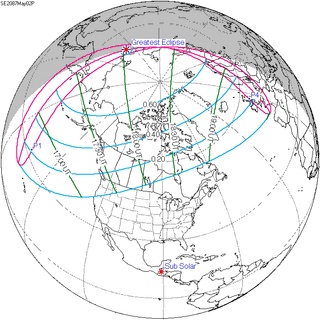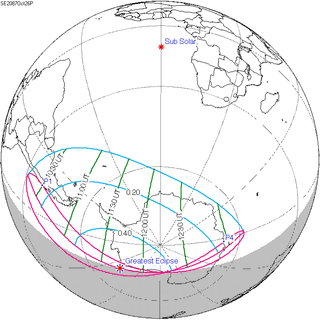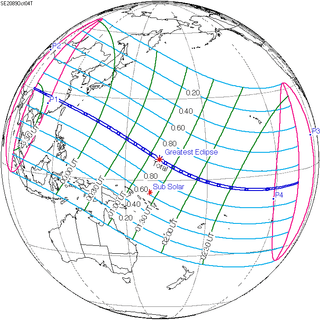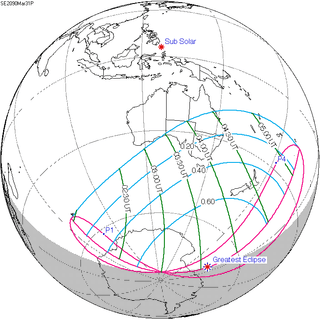Solar eclipse of April 21, 2088
| Solar eclipse of April 21, 2088 | |
|---|---|
 Map | |
| Type of eclipse | |
| Nature | Total |
| Gamma | 0.4135 |
| Magnitude | 1.0474 |
| Maximum eclipse | |
| Duration | 238 sec (3 m 58 s) |
| Coordinates | 36°00′N 15°06′E / 36°N 15.1°E |
| Max. width of band | 173 km (107 mi) |
| Times (UTC) | |
| Greatest eclipse | 10:31:49 |
| References | |
| Saros | 130 (56 of 73) |
| Catalog # (SE5000) | 9706 |
A total solar eclipse will occur on April 21, 2088. A solar eclipse occurs when the Moon passes between Earth and the Sun, thereby totally or partly obscuring the image of the Sun for a viewer on Earth. A total solar eclipse occurs when the Moon's apparent diameter is larger than the Sun's, blocking all direct sunlight, turning day into darkness. Totality occurs in a narrow path across Earth's surface, with the partial solar eclipse visible over a surrounding region thousands of kilometres wide.
Related eclipses
Solar eclipses 2087-2090
Each member in a semester series of solar eclipses repeats approximately every 177 days and 4 hours (a semester) at alternating nodes of the Moon's orbit.
| 120 | May 2, 2087 Partial |
125 | October 26, 2087 Partial |
| 130 | April 21, 2088 Total |
135 | October 14, 2088 Annular |
| 140 | April 10, 2089 Annular |
145 | October 4, 2089 Total |
| 150 | March 31, 2090 Partial |
155 | September 23, 2090 Total |
Notes
References
- Earth visibility chart and eclipse statistics Eclipse Predictions by Fred Espenak, NASA/GSFC
| Wikimedia Commons has media related to Solar eclipse of 2088 April 21. |

